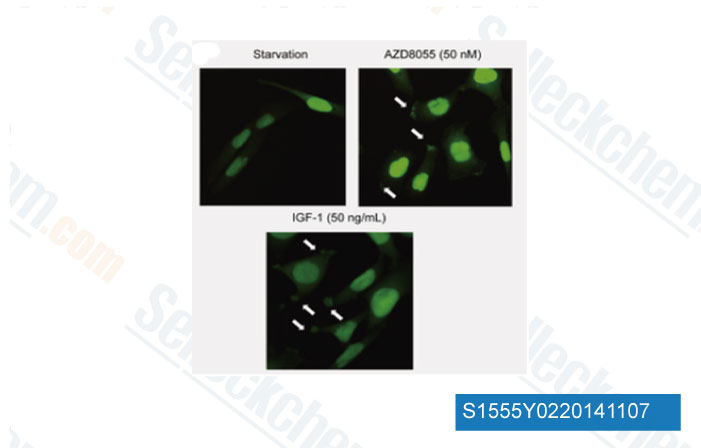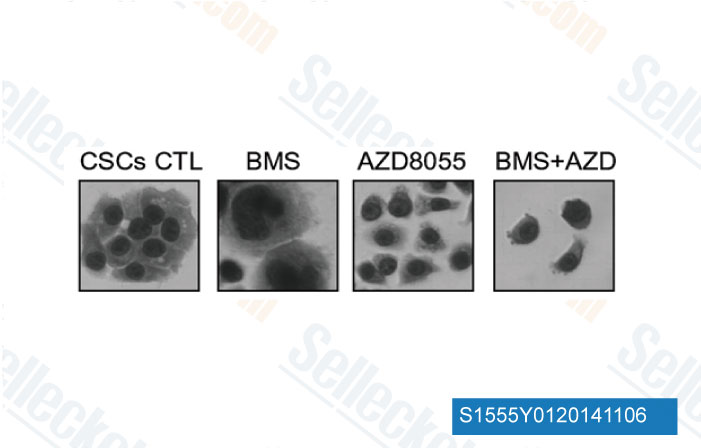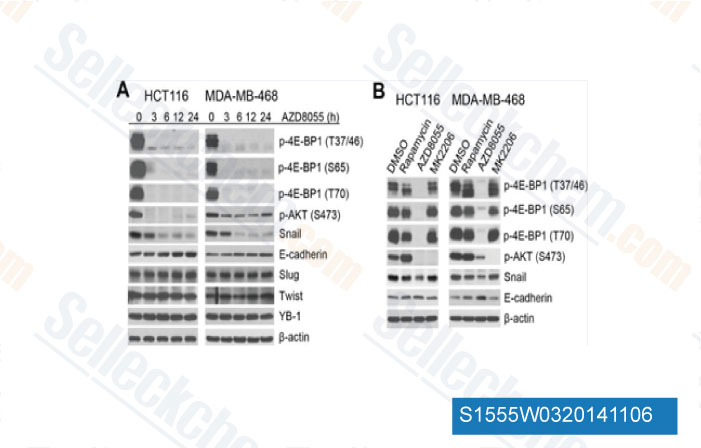|
Toll Free: (877) 796-6397 -- USA and Canada only -- |
Fax: +1-832-582-8590 Orders: +1-832-582-8158 |
Tech Support: +1-832-582-8158 Ext:3 Please provide your Order Number in the email. |
Technical Data
| Formula | C25H31N5O4 |
||||||
| Molecular Weight | 465.54 | CAS No. | 1009298-09-2 | ||||
| Solubility (25°C)* | In vitro | DMSO | 93 mg/mL (199.76 mM) | ||||
| Ethanol | 93 mg/mL (199.76 mM) | ||||||
| Water | Insoluble | ||||||
| In vivo (Add solvents to the product individually and in order) |
|
||||||
|
* <1 mg/ml means slightly soluble or insoluble. * Please note that Selleck tests the solubility of all compounds in-house, and the actual solubility may differ slightly from published values. This is normal and is due to slight batch-to-batch variations. * Room temperature shipping (Stability testing shows this product can be shipped without any cooling measures.) |
|||||||
Preparing Stock Solutions
Biological Activity
| Description | AZD8055 is a novel ATP-competitive mTOR inhibitor with IC50 of 0.8 nM in MDA-MB-468 cells with excellent selectivity (∼1,000-fold) against PI3K isoforms and ATM/DNA-PK. AZD8055 induces caspase-dependent apoptosis and also induces autophagy. Phase 1. | ||||
|---|---|---|---|---|---|
| Targets |
|
||||
| In vitro | AZD8055 shows low activity (∼1,000-fold) against all PI3K isoforms (α, β, γ, δ) and other members of the PI3K-like kinase family (ATM and DNA-PK). AZD8055 inhibits the phosphorylation of mTORC1 (p70S6K and 4E-BP1) as well as phosphorylation of the mTORC2 (Akt) and downstream proteins. The rapamycin-resistant T37/46 phosphorylation sites on 4E-BP1 can be fully inhibited by AZD8055, resulting in significant inhibition of cap-dependent translation. AZD8055 potently inhibits proliferation in U87MG, A549 and H838 cells with IC50 of 53, 50 and 20 nM, respectively. AZD8055 also induces autophagy and increased LC3-II levels in H838 and A549 cells. [1] AZD8055 decreases AML blast cell proliferation and cell cycle progression, reduces the clonogenic growth of leukemic progenitors and induces caspase-dependent apoptosis in leukemic cells but not in normal immature CD34+ cells. [2] AZD8055 indicates inhibitory against the pediatric preclinical testing program (PPTP) cell lines with IC50 of 24.7 nM and induces significant differences in EFS distribution. [3] | ||||
| In vivo | AZD8055 inhibits the pS6 and pAkt in U87MG and A549 xenografts at 2.5/10 mg/kg, which leads to tumor growth inhibition. AZD8055 shows significant antitumor activity in many xenografts, including U87MG, BT474c, A549, Calu-3, LoVo, SW620, PC3 and MES-SA at a dose of 10/20 mg/kg. [1] AZD8055 induces ~40% reduction in tumour volume, accompanied by ablation of phosphorylation of Akt, S6K and SGK protein kinases. Administration of AZD8055 (5mg/kg, Bid) and SAHA (100 mg/kg/d) results in complete tumor growth inhibition in PTEN+/−LKB1+/hypo xenografts without side effects on mice by inhibition of mTORC1 and mTORC2 signaling. [4] | ||||
| Features | First drug to inhibit both types of mTOR protein. |
Protocol (from reference)
| Kinase Assay:[1] |
|
|---|---|
| Cell Assay:[1] |
|
| Animal Study:[1] |
|
References
|
Customer Product Validation

-
Data from [ Int J Cancer , 2014 , 135(10), 2462-74 ]

-
Data from [ Antioxid Redox Signal , 2014 , 20(9), 1382-95 ]

-
Data from [ Mol Cancer Ther , 2014 , 13(1), 37-48 ]

-
Data from [ Oncotarget , 2014 , 5(15), 6015-27 ]
Selleck's AZD8055 Has Been Cited by 275 Publications
| Targeting PI3K inhibitor resistance in breast cancer with metabolic drugs [ Signal Transduct Target Ther, 2025, 10(1):92] | PubMed: 40113784 |
| The miR-451a facilitates natural killer cell-associated immune deficiency after ischemic stroke [ J Cereb Blood Flow Metab, 2025, 0271678X251321641] | PubMed: 39985210 |
| Investigation of dynamic regulation of TFEB nuclear shuttling by microfluidics and quantitative modelling [ Commun Biol, 2025, 8(1):443] | PubMed: 40089585 |
| Dual Inhibition of CDK4/6 and XPO1 Induces Senescence With Acquired Vulnerability to CRBN-Based PROTAC Drugs [ Gastroenterology, 2024, S0016-5085(24)00062-3] | PubMed: 38262581 |
| Cancer cell genetics shaping of the tumor microenvironment reveals myeloid cell-centric exploitable vulnerabilities in hepatocellular carcinoma [ Nat Commun, 2024, 15(1):2581] | PubMed: 38519484 |
| Androgen receptor monomers and dimers regulate opposing biological processes in prostate cancer cells [ Nat Commun, 2024, 15(1):7675] | PubMed: 39227594 |
| MNK-driven eIF4E phosphorylation regulates the fibrogenic transformation of mesenchymal cells and chronic lung allograft dysfunction [ J Clin Invest, 2024, 134(16)e168393] | PubMed: 39145446 |
| FoxO1/Rictor axis induces a nongenetic adaptation to ibrutinib via Akt activation in chronic lymphocytic leukemia [ J Clin Invest, 2024, 134(23)e173770] | PubMed: 39436708 |
| Cell-specific models reveal conformation-specific RAF inhibitor combinations that synergistically inhibit ERK signaling in pancreatic cancer cells [ Cell Rep, 2024, 43(9):114710] | PubMed: 39240715 |
| The combination of breast cancer PDO and mini-PDX platform for drug screening and individualized treatment [ J Cell Mol Med, 2024, 28(9):e18374] | PubMed: 38722288 |
RETURN POLICY
Selleck Chemical’s Unconditional Return Policy ensures a smooth online shopping experience for our customers. If you are in any way unsatisfied with your purchase, you may return any item(s) within 7 days of receiving it. In the event of product quality issues, either protocol related or product related problems, you may return any item(s) within 365 days from the original purchase date. Please follow the instructions below when returning products.
SHIPPING AND STORAGE
Selleck products are transported at room temperature. If you receive the product at room temperature, please rest assured, the Selleck Quality Inspection Department has conducted experiments to verify that the normal temperature placement of one month will not affect the biological activity of powder products. After collecting, please store the product according to the requirements described in the datasheet. Most Selleck products are stable under the recommended conditions.
NOT FOR HUMAN, VETERINARY DIAGNOSTIC OR THERAPEUTIC USE.
